Abstract
Superconductivity in highly pressurized hydrides has become the primary direction for the exploration of the fundamental upper limit of the superconducting transition temperature, , after Drozdov et al. (Nature 2015, 525, 73) discovered a superconducting state with in highly compressed sulfur hydride. To date, several dozen high-temperature superconducting polyhydrides have been discovered and, in addition, it was recently reported that highly compressed titanium and scandium exhibit record-high (up to 36 K). This exceeded the value of niobium many times over, which was the record-high ambient pressure metallic superconductor. Here, we analyzed the experimental data for the recently discovered high-pressure superconductors (which exhibit high transition temperatures within their classes): elemental titanium (Zhang et al., Nature Communications 2022; Liu et al., Phys. Rev. B 2022), (He et al., Chinese Phys. Lett. 2023), (Song et al., Phys. Rev. Lett. 2023), black phosphorous (Li et al., Proc. Natl. Acad. Sci. 2018; Jin et al., arXiv 2023), and violet (Wu et al., arXiv 2023) phosphorous to reveal the nonadiabaticity strength constant (where is the Debye temperature, and the Fermi temperature) in these superconductors. The analysis showed that the -phase of titanium and black phosphorous exhibits scores that are nearly identical to those associated with A15 superconductors, while the studied hydrides and violet phosphorous exhibit constants in the same ballpark as those of and .
1. Introduction
The discovery of near-room-temperature superconductivity in highly compressed sulfur hydride by Drozdov et al. [1] presented a new era in superconductivity. This research field represents one of the most fascinating scientific and technological explorations in modern condensed-matter physics. In this area of research, advanced first-principles calculations [2,3,4,5,6,7,8,9,10,11] are essential parts of the experimental quest for the discovery of new hydrides phases [12,13,14,15,16,17,18,19,20,21], and both of these directions drive the development of new experimental techniques with which to study highly pressurized materials [22,23,24,25,26,27,28,29,30,31].
From 2015 until now, several dozen high-temperature superconducting polyhydride phases have been discovered and studied [1,12,13,14,15,16,17,18,19,20,21,24,32,33,34,35,36,37,38,39,40,41,42,43,44,45]. At the same time, high-pressure studies of superconductivity and high-pressure material synthesis [46,47,48] in non-hydrides (including cuprates [49,50,51,52]) have also progressed [53,54,55,56,57,58,59,60,61,62], including the observation of in highly compressed elemental titanium [63,64] and scandium [65,66], and the discovery that [67,68] and [69] in .
First-principles calculations [12,13,14,15,16,17,18,19,20,21,70,71,72,73,74,75,76,77,78,79] are essential tools in the quest for room-temperature superconductivity (they were used [76] to explain the experimental results [80] for one of the most difficult-to-explain hydride cases, ), and the primary calculated parameter in these calculations is the transition temperature, . In addition, another difficult-to-explain hydride should be mentioned, which is LiPdHx [46]. This hydride was synthesized at high pressure in a bulk form [46]; however, as was predicted by the first-principles calculations, the high transition temperature [81] was not confirmed by the experiment [46].
Thus, the experiment [1,3,25] remains the final criterion. Therefore, the confirmation of the predicted in order to determine the other fundamental ground-state parameters, including the upper critical field, ; the lower critical field, [12,22]; the self-field critical current density, [24,82,83,84]; the London penetration depth, [22,23,85,86]; the superconducting energy gap amplitude, [87,88,89]; and gap symmetry [90,91]; is the task of the experiment and the data analysis.
Another complication in understanding the superconductivity of highly-pressurized materials is the phenomenon of nonadiabaticity, which originates from the fact that the Migdal–Eliashberg theory of the electron–phonon-mediated superconductivity [92,93] is based on the primary assumption/postulate that the superconductor obeys the inequality:
where is the Debye temperature and is the Fermi temperature. In other words, Equation (1) implies that the superconductor exhibits fast electric charge carriers and slow ions. This assumption simplifies the theoretical model of electron–phonon-mediated superconductivity; however, Equation (1) is not satisfied for many unconventional superconductors [94,95,96,97,98,99,100,101,102] (which was first pointed out by Pietronero and co-workers [103,104,105,106]) and many highly compressed superconductors [91,101,107,108,109].
While the theoretical aspects of the nonadiabatic effects can be found elsewhere [11,94,100,103,104,105,106,107], in practice, the strength of the nonadiabatic effects can be quantified via the ratio [101,102], for which, in Ref. [101], three characteristic ranges were proposed:
It was found in Ref. [101], and confirmed in Ref. [91], that superconductors with (from a dataset of 46 superconductors from all major superconductor families) exhibit the ratio in the range .
This is an interesting and theoretically unexplained empirical observation.
In this study, we further extended the empirical database by deriving several fundamental parameters:
- (1)
- the Debye temperature, ;
- (2)
- the electron–phonon coupling constant, ;
- (3)
- the ground-state coherence length, ;
- (4)
- the Fermi temperature, ;
- (5)
- the nonadiabaticity strength constant, ;
- (6)
- and the ratio, ;
for five recently discovered highly compressed superconductors for which the reported raw experimental data are enough to deduce the above-mentioned parameters. These superconductors represent materials with high or record-high in their families:
- (1)
- elemental titanium, [63,64];
- (2)
- [21];
- (3)
- [110];
- (4)
- black phosphorous [111,112,113,114];
- (5)
- violet phosphorous [62].
In the result, we derived the nonadiabaticity strength constant, , for these superconductors. Derived values confirmed the previously reported empirical observation [91,101] that the superconductors with obey the condition .
2. Utilized Models and Data Analysis Tools
2.1. Debye Temperature
Within electron–phonon phenomenology, the Debye temperature, , is a fundamental parameters that determines the superconducting transition temperature, [93,115,116,117,118,119]. can be deduced as a free-fitting parameter from a fit of temperature-dependent resistance, , to the Bloch–Grüneisen (BG) equation [120,121,122,123]:
where , , , and are free-fitting parameters.
2.2. The Electron–Phonon Coupling Constant
From the deduced , the electron–phonon coupling constant, , can be calculated as the root of advanced McMillan equation [116,117,118,119]:
where
where is the Coulomb pseudopotential parameter, which we assumed to be (which is the typical value utilized in the first-principles calculation for many electron–phonon-mediated superconductors [63,124]). In Equations (4)–(6), we defined the by a strict resistance criterion of , where is the sample resistance at the onset of the transition.
2.3. Ground-State Coherence Length
We used a model proposed by Baumgartner et al. [125,126,127] to fit the upper critical field dataset, , and determine the ground-state coherence length :
where is the superconducting flux quantum, is Planck constant, , and and are free fitting parameters.
2.4. The Fermi Temperature
The Fermi temperature, , can be calculated by using a simple expression of the free-electron model [128,129]:
where is bare electron mass, is reduced Planck constant, is Boltzmann constant, and is the charge carrier density per volume (). Equation (8) can be used if the Hall resistance experiments are performed, and the charge carrier density, , is established.
If Hall resistance measurements do not perform, then can be calculated using the equation [58,59]:
where is the gap-to-transition temperature ratio. This parameter is the only unknown parameter in Equation (9).
2.5. The Gap-to-Transition Temperature Ratio
To calculate the Fermi temperature using Equation (9), there is a need to know . To determine , we utilized the following approach. Carbotte [124] collected various parameters for 32 electron–phonon-mediated superconductors that exhibit and . In Figure 1, we presented the dataset reported by Carbotte in Table IV [124]. The dependence can be approximated using a linear function (Figure 1) [130]:
where , and .
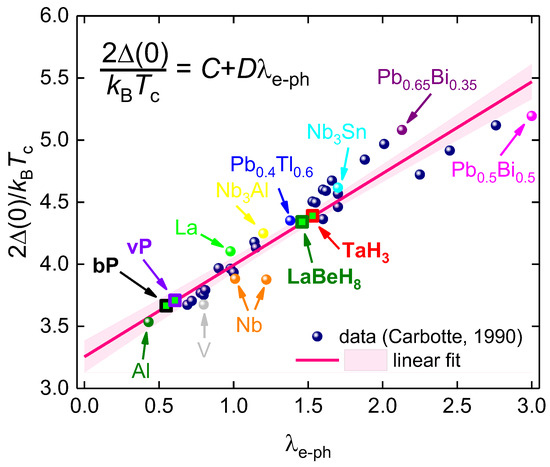
Figure 1.
The gap-to-transition temperature ratio, , vs. the electron–phonon coupling constant, , dataset reported by Carbotte in Table IV of Ref. [124]. A linear fit is shown by the pink line. Positions for some representative superconductors and superconductors studied in this report (where bP stands for black phosphorus and vP stands for violet phosphorus) are shown. The pink shadow area indicates 95% confidence bands for the linear fit.
Insofar as is known, the ratio can be estimated from Equation (10).
3. Results
3.1. Highly Compressed Titanium
Zhang et al. [63] and Liu et al. [64] reported record-high in the phase compressed at megabar pressures. In Figure 2, we show the fit of the dataset measured by Zhang et al. [63] for the phase compressed at to Equation (3).
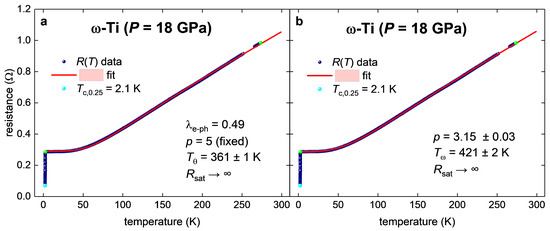
Figure 2.
Temperature-dependent resistance data, R(T), for compressed titanium (-phase at P = 18 GPa) and data fit to Equation (3) (raw data reported by Zhang et al. [63]). Green balls indicate the bounds for which R(T) data were used for the fit to Equation (3). (a) Fit to Debye model: , , , , fit quality is 0.99988. (b) Fit to Equation (3): , , , fit quality is 0.99995. The pink shadow areas in both panels show 95% confidence bands.
The deduced Debye temperature (Figure 2a) for -phase () is . This value is within the ballpark value for for uncompressed titanium, which exhibits a phase [131].
To calculate the electron–phonon coupling strength constant, , using Equations (4)–(6), we defined the superconducting transition temperature, , with the criterion. This criterion was chosen based on the lowest temperature at which experimental data measuring at were reported by Zhang et al. [63]. The deduced value is very close to the of pure elemental aluminum (Figure 1, and Ref. [124]).
We also confirmed the power-law exponent (reported by Zhang et al. [63]) for the temperature-dependent . Zhang et al. [63] extracted this power-law exponent from the simple power-law fit of at the temperature range of :
where , , and are free-fitting parameters. As we showed earlier [132], Equation (11) does not always return correct -values. The reliable approach is to fit the data to Equation (3), where is a free-fitting parameter. For the given case, our fit to Equation (3) (Figure 2b) returns the same power-law exponent, , as the one reported by Zhang et al. [63].
In Figure 3, we show data measured by Zhang et al. [63] and Liu et al. [64] and the results of data fitting to Equations (3)–(7) for the phase compressed at (Figure 3a), (Figure 3b), (Figure 3c), and (Figure 3d).
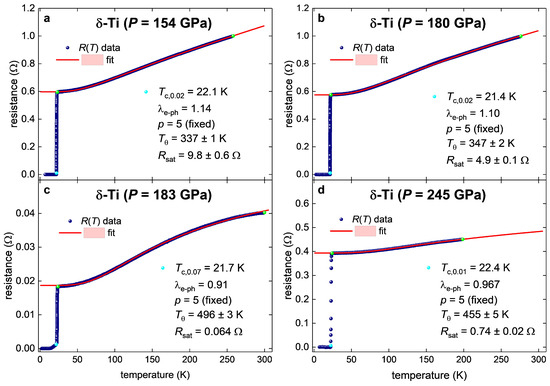
Figure 3.
Temperature-dependent resistance data, R(T), for compressed titanium (-phase) and fit to the Debye model (Equation (3), ). Raw data were reported by Zhang et al. [63] (Panels (a,b,d)) and Liu et al. [64] (Panel (c)). Green balls indicate the bounds for which R(T) data were used for the fit to Equation (3). Deduced parameters are (a) , , , fit quality is 0.99992. (b) , , , fit quality is 0.9998. (c) , , , fit quality is 0.9996. (d) , , , fit quality is 0.9997. The pink shadow areas show 95% confidence bands.
Liu et al. [64] reported and logarithmic frequency for highly compressed titanium over a wide range of applied pressure calculated using first-principles calculations. In Figure 4, we present a comparison of the deduced and values from the experiment and show the calculation results [64]. To compare (calculated using first-principles calculations) and deduced from the experiment, we used the theoretical expression proposed by Semenok [133]:
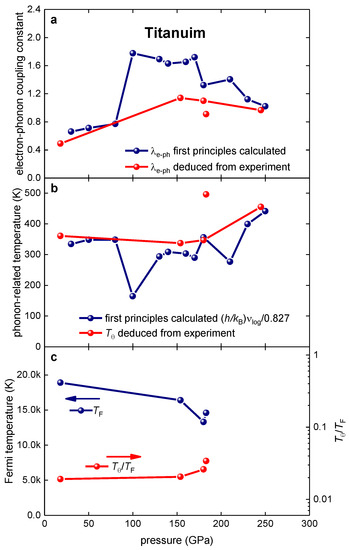
Figure 4.
Evolution of (a) the electron–phonon coupling constant ; (b) characteristic phonon temperatures and ; and (c) Fermi temperature, , calculated using Equation (8) and the used of carrier density reported by Zhang et al. [63] and deduced (in Panel (a)) and the nonadiabaticity strength constant, , for highly compressed titanium.
In Figure 4c, we also show values calculated using Equation (8), where we used derived and bulk density of charge carriers in compressed titanium, , measured by Zhang et al. [63]. Zhang et al. [63] reported the and measured at different pressures. For , calculations we assumed the following approximations: ; ; and .
The evolution of the adiabaticity strength constant vs. pressure is shown in Figure 4c.
Figure 4 shows a very good agreement between values calculated using first-principles calculations and extracted from experiment and characteristic phonon temperatures, and , at low and high applied pressures. More experimental data are required to perform detailed comparison.
The derived , , and , values for highly compressed titanium are shown in Figure 5, Figure 6 and Figure 7, together with values for the main superconducting families. It should be noted that other global scaling laws utilize different variables [83,134,135,136,137,138,139,140].
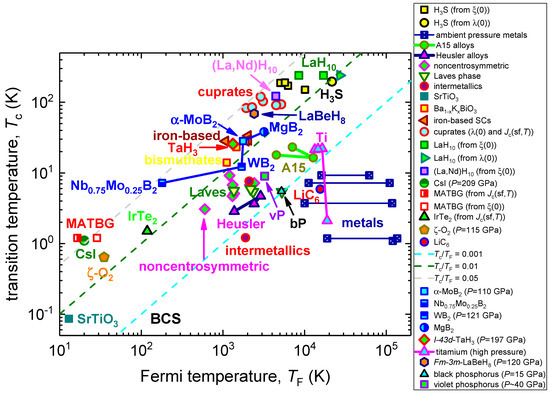
Figure 5.
Uemura plot, where highly compressed , , , black, and violet phosphorous (BP and VP, respectively) are shown together with several families of superconductors: metals, iron-based superconductors, diborides, cuprates, Laves phases, hydrides, and others. References for original data can be found in Refs. [91,101,141,142].
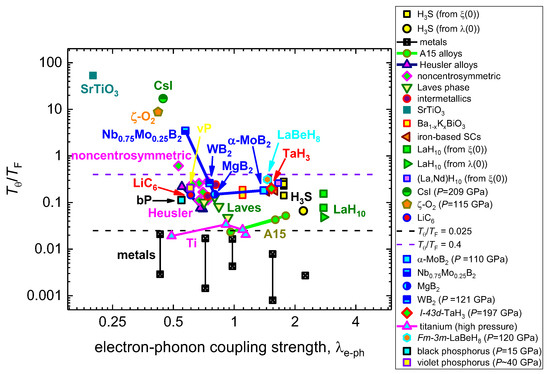
Figure 6.
The nonadiabaticity strength constant where several families of superconductors and highly compressed , , , black, and violet phosphorous are shown. References for original data can be found in Refs. [91,101,141,142].
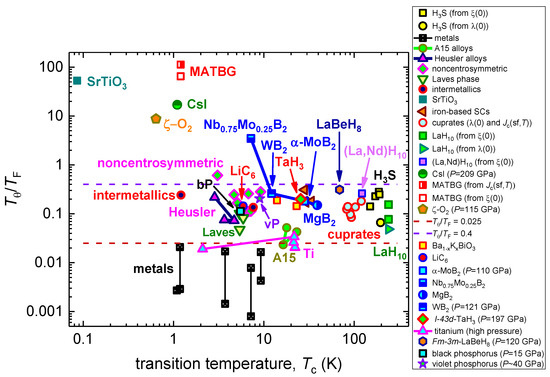
Figure 7.
The nonadiabaticity strength constant for several families of superconductors and highly compressed , , , black, and violet phosphorous are shown. References for original data can be found in Refs. [91,101,141,142].
3.2. Highly Compressed I-43d-Phase of TaH3
Recently, He et al. [21] reported on the observation of high-temperature superconductivity in the highly compressed I-43d-phase of TaH3. In Figure 8, we show the fit of the dataset (measured by He et al. [21]) for the tantalum hydride compressed at .
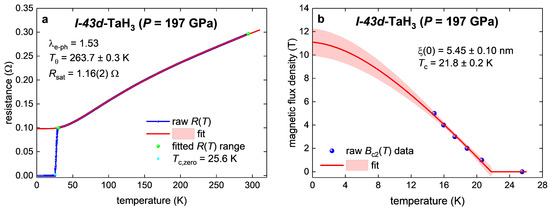
Figure 8.
Analyzed experimental data for I-43d-phase of TaH3 at P = 197 GPa (raw data reported by He et al. [21]). (a) Temperature-dependent resistance data, R(T), and data fit to Equation (3). Green balls indicate the bounds for which R(T) data were used for the fit to Equation (3). Deduced , , , fit quality is 0.99998. (b) The upper critical field data, Bc2(T), and data fit to Equation (7). Definition Bc2(T) criterion of was used. Deduced parameters are: , . Fit quality is 0.9943. The pink shadow areas in both panels show 95% confidence bands.
We deduced (Figure 8) by using Equations (4)–(6). The deduced value was within the ballpark value for other highly compressed hydride superconductors [3,119].
He et al. [21] did not report the result of the Hall coefficient measurements. Based on this, we determined the Fermi temperature using Equation (9). To do this, we deduced the dataset from R(T,B) curves reported by He et al. [21] in their Figure 2a [21]. We defined the using the criterion of . Obtained data and the data fit are shown in Figure 8b. Deduced .
To calculate the Fermi temperature in the I-43d-phase of TaH3 at P = 197 GPa, we substituted derived and in Equation (9), where was obtained by substituting in Equation (10) (Figure 1).
In the result, we determined the following fundamental parameters of the I-43d-phase of TaH3 ():
- (1)
- the Debye temperature, ;
- (2)
- the electron–phonon coupling constant, ;
- (3)
- the ground-state coherence length, ;
- (4)
- the Fermi temperature, ;
- (5)
- , which implies that this phase falls in the unconventional superconductors band in the Uemura plot;
- (6)
- the nonadiabaticity strength constant, .
3.3. Highly Compressed Fm-3m-Phase of LaBeH8
Recently, Song et al. [110] reported on the observation of high-temperature superconductivity in highly compressed LaBeH8. The crystalline structure of this superhydride at was identified as . This crystalline structure was predicted by Zhang et al. [143]. Figure 9a shows the fit of the dataset (measured by Song et al. [110]) in the LaBeH8 compressed at .
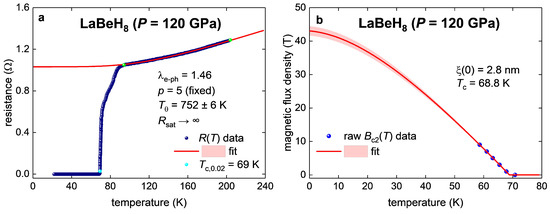
Figure 9.
Analyzed experimental data for -phase of LaBeH8 at P = 120 GPa (raw data reported by Song et al. [110]). (a) Temperature-dependent resistance data, R(T), and data fit to Equation (3). Green balls indicate the bounds for which R(T) data were used for the fit to Equation (3). Deduced , , , fit quality is 0.9990. (b) The upper critical field data, Bc2(T), and data fit to Equation (7). Definition Bc2(T) criterion of was used. Deduced parameters are: , . Fit quality is 0.9995. The pink areas in both panels show 95% confidence bands.
The dataset was extracted from R(T,B) curves reported by Song et al. [110] in their Figure 3a [110]. For the definition, we utilized the criterion of . The obtained data and the data fit are shown in Figure 9b. Deduced .
Examining the results of the performed study, we determined that the -phase of LaBeH8 at P = 120 GPa exhibits the following parameters:
- (1)
- the Debye temperature, ;
- (2)
- the electron–phonon coupling constant, ;
- (3)
- the ground-state coherence length, ;
- (4)
- the Fermi temperature, ;
- (5)
- , which implies that this phase falls in the unconventional superconductors band in the Uemura plot;
- (6)
- the nonadiabaticity strength constant, .
3.4. Highly Compressed Black Phosphorous
The impact of high pressure on the superconducting parameters of black phosphorous has been studied over several decades [111,112,113,114]. Recent detailed studies in this field have been reported by Guo et al. [112], Li et al. [111], and Jin et al. [114].
To show the reliability of high-pressure studies of superconductors (which was recently questioned by non-experts in the field [144,145]), in Figure 10, we show raw datasets measured at from the two independent research groups of Shirotani et al. [113] and Li et al. [111]. It should be stressed that these reports have been published within a timeframe of 24 years.
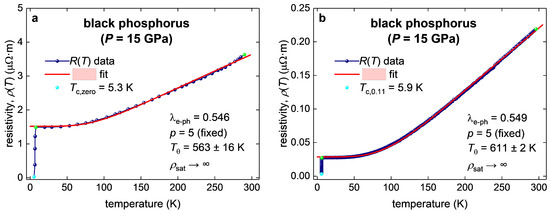
Figure 10.
Analysis of experimental datasets for black phosphorus compressed at P = 15 GPa reported by (a) Shirotani et al. [113] and by (b) Li et al. [111]. Green balls indicate the bounds for which data were used for the fit to Equation (3). Deduced parameters are: (a) , , , fit quality is 0.9983; (b) , , , fit quality is 0.9998. The pink shadow areas in both panels 95% confidence bands.
The agreement between deduced (Figure 10) from two datasets [111,113] is remarkable. It should be noted that the approach used for our analysis (Figure 10) was developed to analyze data measured in highly compressed near-room-temperature superconductors [119]. This feature implies that several concerns expressed by non-experts in the field [144,145,146,147] with regard to highly compressed near-room-temperature hydride superconductors do not have any scientific background.
Figure 11 shows datasets extracted from raw datasets measured at very close pressures, with values of [112] (panel a) and [111] (panel b). These two datasets were reported by two independent groups. For the definition, we utilized the same strict criterion of for both datasets in Figure 11.
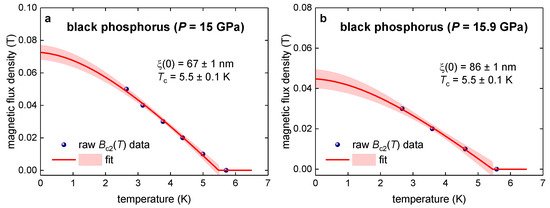
Figure 11.
Analysis of experimental datasets for black phosphorus compressed at (a) P = 15 GPa reported by Li et al. [111], and (b) P = 15.9 GPa reported by Guo et al. [112]. Deduced parameters are: (a) , , fit quality is 0.9965; (b) , , fit quality is 0.9981. Pink shadow areas in both panels show 95% confidence bands are shown.
The average deduced parameters for black phosphorus , which we derived from experimental data analysis reported by three different research groups, are as follows:
- (1)
- the Debye temperature, ;
- (2)
- the electron–phonon coupling constant, ;
- (3)
- the ground-state coherence length, ;
- (4)
- the Fermi temperature, ;
- (5)
- , which implies that black phosphorus falls in the conventional superconductors band in the Uemura plot;
- (6)
- the nonadiabaticity strength constant, .
The deduced parameters show that the black phosphorus at exhibits low-strength nonadiabatic effects.
3.5. Highly Compressed Violet Phosphorous
Recently, Wu et al. [62] reported on the observation of the superconducting state in compressed violet phosphorus (vP). This material exhibits at high pressure in the range of . In Figure 12a, we showed the dataset (measured by Wu et al. [62]) and fitted data to Equation (3).
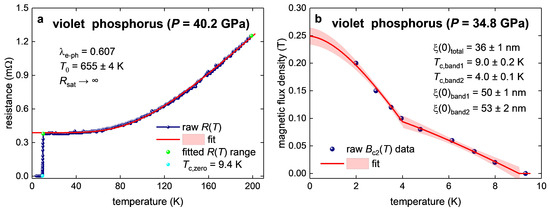
Figure 12.
Analysis of experimental data for violet phosphorus compressed at (a) and (b) . Raw data reported by Wu et al. [62]. (a) Temperature-dependent resistance data, R(T), and data fit to Equation (3). Green balls indicate the bounds for which R(T) data were used for the fit to Equation (3). Deduced , , , fit quality is 0.9991. (b) The upper critical field data, Bc2(T), and data fit to Equation (13). Definition Bc2(T) criterion of was used. The deduced parameters are: , , , . Fit quality is 0.9977. The pink areas in both panels show 95% confidence bands.
The dataset was extracted from the only R(T,B) dataset reported by Wu et al. [62] for material compressed at [62]. The was defined by the criterion of . The deduced dataset is shown in Figure 12b. Equation (7) does not fit the data well because the goes up at . We think this means a second band opens up, so we used a two-band model to fit the data [141,148]:
where , and exhibit their independent transition temperature and the coherence length. We list deduced values in the figure caption to Figure 12. However, for further analysis, we used , and .
In the result, we derived the following parameters for violet phosphorus compressed at :
- (1)
- the Debye temperature, ;
- (2)
- the electron–phonon coupling constant, ;
- (3)
- the ground-state coherence length, ;
- (4)
- the Fermi temperature, ;
- (5)
- , which implies that this phase falls near the conventional superconductors band in the Uemura plot;
- (6)
- the nonadiabaticity strength constant, .
We concluded, that nonadiabatic effects in violet phosphorus compressed at are like those in and near-room-temperature superconductors.
4. Discussion
As we mentioned, above superconductors can be classified by the ratio of maximum phonon energy, (where is Debye frequency) to the charge carrier energy at the Fermi level, . For practical use, it is more convenient to replace the with , where is the Debye temperature.
Thus, in the adiabatic regime, , superconductors have fast charge carriers and slow phonons. This condition is satisfied for pure metals and some superconducting alloys (Figure 5, Figure 6 and Figure 7).
However, as can be seen in Figure 6 and Figure 7, more than ¾ of superconductors (including important for practical use Nb3Sn, MgB2, pnictides, cuprates, and record-high Tc near-room-temperature superconducting hydrides) have the ratio in a different range [91,101]:
Our experimental data search [70,80] revealed that only six superconductors exhibit (Figure 6 and Figure 7):
These materials are [91,101]: Nb0.75Mo0.25B2 and Nb0.5Os0.5, which are highly compressed metalized oxygen; magic-angle twisted bilayer graphene SrTiO3; and highly compressed metalized ionic salt, CsI. It should be stressed that all these superconductors exhibit low transition temperatures, .
The five recently discovered superconductors (Section 3.1, Section 3.2, Section 3.3, Section 3.4 and Section 3.5) studied in this report confirmed the validity of Equation (14). And, thus, perhaps a deep physical origin related to the strength of the nonadiabaticity within the range indicated in Equation (14) can be revealed.
Nonadiabatic effects are crucial in reducing the superconducting transition temperature to well below the value predicted by classical (BCS-Eliashberg) theories of electron–phonon-mediated superconductivity [93,115]. This understanding was first reported by Pietronero and co-workers [103,104,105,107]. It can be seen in Figure 7 that materials with the highest strength of nonadiabaticity (for instance, SrTiO3 and magic-angle twisted bilayer graphene) exhibit the superconducting transition temperature , while all materials with exhibit within a range indicated by Equation (14).
5. Conclusions
In this work, we analyzed experimental data for five new highly compressed superconductors: [63,64], [21], [110], black phosphorous [111,112,113], and violet phosphorous [62]. We established several superconducting parameters for these superconductors, including the strength of nonadiabaticity, .
Funding
This research was funded by the Ministry of Science and Higher Education of the Russian Federation, grant number No. 122021000032-5 (theme “Pressure”). The research funding from the Ministry of Science and Higher Education of the Russian Federation (Ural Federal University Program of Development within the Priority-2030 Program) is gratefully acknowledged.
Data Availability Statement
Not applicable.
Conflicts of Interest
The author declares no conflict of interest. The funders had no role in the design of the study; in the collection, analyses, or interpretation of data; in the writing of the manuscript; or in the decision to publish the results.
References
- Drozdov, A.P.; Eremets, M.I.; Troyan, I.A.; Ksenofontov, V.; Shylin, S.I. Conventional Superconductivity at 203 Kelvin at High Pressures in the Sulfur Hydride System. Nature 2015, 525, 73–76. [Google Scholar] [CrossRef] [PubMed]
- Duan, D.; Liu, Y.; Tian, F.; Li, D.; Huang, X.; Zhao, Z.; Yu, H.; Liu, B.; Tian, W.; Cui, T. Pressure-Induced Metallization of Dense (H2S)2H2 with High-Tc Superconductivity. Sci. Rep. 2014, 4, 6968. [Google Scholar] [CrossRef] [PubMed]
- Lilia, B.; Hennig, R.; Hirschfeld, P.; Profeta, G.; Sanna, A.; Zurek, E.; Pickett, W.E.; Amsler, M.; Dias, R.; Eremets, M.I.; et al. The 2021 Room-Temperature Superconductivity Roadmap. J. Phys. Condens. Matter 2022, 34, 183002. [Google Scholar] [CrossRef] [PubMed]
- Li, Y.; Hao, J.; Liu, H.; Li, Y.; Ma, Y. The Metallization and Superconductivity of Dense Hydrogen Sulfide. J. Chem. Phys. 2014, 140, 174712. [Google Scholar] [CrossRef]
- Sun, D.; Minkov, V.S.; Mozaffari, S.; Sun, Y.; Ma, Y.; Chariton, S.; Prakapenka, V.B.; Eremets, M.I.; Balicas, L.; Balakirev, F.F. High-Temperature Superconductivity on the Verge of a Structural Instability in Lanthanum Superhydride. Nat. Commun. 2021, 12, 6863. [Google Scholar] [CrossRef]
- Ma, L.; Wang, K.; Xie, Y.; Yang, X.; Wang, Y.; Zhou, M.; Liu, H.; Yu, X.; Zhao, Y.; Wang, H.; et al. High-Temperature Superconducting Phase in Clathrate Calcium Hydride CaH6 up to 215 K at a Pressure of 172 GPa. Phys. Rev. Lett. 2022, 128, 167001. [Google Scholar] [CrossRef]
- Wang, H.; Tse, J.S.; Tanaka, K.; Iitaka, T.; Ma, Y. Superconductive Sodalite-like Clathrate Calcium Hydride at High Pressures. Proc. Natl. Acad. Sci. USA 2012, 109, 6463–6466. [Google Scholar] [CrossRef]
- Bi, J.; Nakamoto, Y.; Zhang, P.; Shimizu, K.; Zou, B.; Liu, H.; Zhou, M.; Liu, G.; Wang, H.; Ma, Y. Giant Enhancement of Superconducting Critical Temperature in Substitutional Alloy (La,Ce)H9. Nat. Commun. 2022, 13, 5952. [Google Scholar] [CrossRef]
- Du, M.; Song, H.; Zhang, Z.; Duan, D.; Cui, T. Room-Temperature Superconductivity in Yb/Lu Substituted Clathrate Hexahydrides under Moderate Pressure. Research 2022, 2022, 9784309. [Google Scholar] [CrossRef]
- Alarco, J.A.; Almutairi, A.; Mackinnon, I.D.R. Progress Towards a Universal Approach for Prediction of the Superconducting Transition Temperature. J. Supercond. Nov. Magn. 2020, 33, 2287–2292. [Google Scholar] [CrossRef]
- Kostrzewa, M.; Szczęśniak, K.M.; Durajski, A.P.; Szczęśniak, R. From LaH10 to Room–Temperature Superconductors. Sci. Rep. 2020, 10, 1592. [Google Scholar] [CrossRef]
- Drozdov, A.P.; Kong, P.P.; Minkov, V.S.; Besedin, S.P.; Kuzovnikov, M.A.; Mozaffari, S.; Balicas, L.; Balakirev, F.F.; Graf, D.E.; Prakapenka, V.B.; et al. Superconductivity at 250 K in Lanthanum Hydride under High Pressures. Nature 2019, 569, 528–531. [Google Scholar] [CrossRef] [PubMed]
- Somayazulu, M.; Ahart, M.; Mishra, A.K.; Geballe, Z.M.; Baldini, M.; Meng, Y.; Struzhkin, V.V.; Hemley, R.J. Evidence for Superconductivity above 260 K in Lanthanum Superhydride at Megabar Pressures. Phys. Rev. Lett. 2019, 122, 027001. [Google Scholar] [CrossRef] [PubMed]
- Semenok, D.V.; Kvashnin, A.G.; Ivanova, A.G.; Svitlyk, V.; Fominski, V.Y.; Sadakov, A.V.; Sobolevskiy, O.A.; Pudalov, V.M.; Troyan, I.A.; Oganov, A.R. Superconductivity at 161 K in Thorium Hydride ThH10: Synthesis and Properties. Mater. Today 2020, 33, 36–44. [Google Scholar] [CrossRef]
- Troyan, I.A.; Semenok, D.V.; Kvashnin, A.G.; Sadakov, A.V.; Sobolevskiy, O.A.; Pudalov, V.M.; Ivanova, A.G.; Prakapenka, V.B.; Greenberg, E.; Gavriliuk, A.G.; et al. Anomalous High-Temperature Superconductivity in YH6. Adv. Mater. 2021, 33, 2006832. [Google Scholar] [CrossRef]
- Semenok, D.V.; Troyan, I.A.; Ivanova, A.G.; Kvashnin, A.G.; Kruglov, I.A.; Hanfland, M.; Sadakov, A.V.; Sobolevskiy, O.A.; Pervakov, K.S.; Lyubutin, I.S.; et al. Superconductivity at 253 K in Lanthanum–Yttrium Ternary Hydrides. Mater. Today 2021, 48, 18–28. [Google Scholar] [CrossRef]
- Kong, P.; Minkov, V.S.; Kuzovnikov, M.A.; Drozdov, A.P.; Besedin, S.P.; Mozaffari, S.; Balicas, L.; Balakirev, F.F.; Prakapenka, V.B.; Chariton, S.; et al. Superconductivity up to 243 K in the Yttrium-Hydrogen System under High Pressure. Nat. Commun. 2021, 12, 5075. [Google Scholar] [CrossRef]
- Zhang, C.; He, X.; Li, Z.; Zhang, S.; Feng, S.; Wang, X.; Yu, R.; Jin, C. Superconductivity in Zirconium Polyhydrides with Tc above 70 K. Sci. Bull. 2022, 67, 907–909. [Google Scholar] [CrossRef]
- Zhang, C.L.; He, X.; Li, Z.W.; Zhang, S.J.; Min, B.S.; Zhang, J.; Lu, K.; Zhao, J.F.; Shi, L.C.; Peng, Y.; et al. Superconductivity above 80 K in Polyhydrides of Hafnium. Mater. Today Phys. 2022, 27, 100826. [Google Scholar] [CrossRef]
- Minkov, V.S.; Prakapenka, V.B.; Greenberg, E.; Eremets, M.I. A Boosted Critical Temperature of 166 K in Superconducting D3S Synthesized from Elemental Sulfur and Hydrogen. Angew. Chem. 2020, 132, 19132–19136. [Google Scholar] [CrossRef]
- He, X.; Zhang, C.L.; Li, Z.W.; Zhang, S.J.; Min, B.S.; Zhang, J.; Lu, K.; Zhao, J.F.; Shi, L.C.; Peng, Y.; et al. Superconductivity Observed in Tantalum Polyhydride at High Pressure. Chin. Phys. Lett. 2023, 40, 057404. [Google Scholar] [CrossRef]
- Minkov, V.S.; Bud’ko, S.L.; Balakirev, F.F.; Prakapenka, V.B.; Chariton, S.; Husband, R.J.; Liermann, H.P.; Eremets, M.I. Magnetic Field Screening in Hydrogen-Rich High-Temperature Superconductors. Nat. Commun. 2022, 13, 3194. [Google Scholar] [CrossRef] [PubMed]
- Minkov, V.S.; Ksenofontov, V.; Bud’ko, S.L.; Talantsev, E.F.; Eremets, M.I. Magnetic Flux Trapping in Hydrogen-Rich High-Temperature Superconductors. Nat. Phys. 2023; online ahead of print. [Google Scholar] [CrossRef]
- Troyan, I.A.; Semenok, D.V.; Ivanova, A.G.; Sadakov, A.V.; Zhou, D.; Kvashnin, A.G.; Kruglov, I.A.; Sobolevskiy, O.A.; Lyubutina, M.V.; Perekalin, D.S.; et al. Non-Fermi-Liquid Behavior of Superconducting SnH4. arXiv 2023, arXiv:2303.06339. [Google Scholar] [CrossRef]
- Flores-Livas, J.A.; Boeri, L.; Sanna, A.; Profeta, G.; Arita, R.; Eremets, M. A Perspective on Conventional High-Temperature Superconductors at High Pressure: Methods and Materials. Phys. Rep. 2020, 856, 1–78. [Google Scholar] [CrossRef]
- Bhattacharyya, P.; Chen, W.; Huang, X.; Chatterjee, S.; Huang, B.; Kobrin, B.; Lyu, Y.; Smart, T.J.; Block, M.; Wang, E.; et al. Imaging the Meissner Effect and Flux Trapping in a Hydride Superconductor at Megabar Pressures Using a Nanoscale Quantum Sensor. arXiv 2023, arXiv:2306.03122. [Google Scholar] [CrossRef]
- Goh, S.K.; Zhang, W.; Yip, K.Y. Trapped Magnetic Flux in Superconducting Hydrides. Nat. Phys. 2023; online ahead of print. [Google Scholar] [CrossRef]
- Ho, K.O.; Leung, M.Y.; Wang, W.; Xie, J.; Yip, K.Y.; Wu, J.; Goh, S.K.; Denisenko, A.; Wrachtrup, J.; Yang, S. Spectroscopic Study of N-V Sensors in Diamond-Based High-Pressure Devices. Phys. Rev. Appl. 2023, 19, 044091. [Google Scholar] [CrossRef]
- Ho, K.O.; Leung, M.Y.; Reddy, P.; Xie, J.; Wong, K.C.; Jiang, Y.; Zhang, W.; Yip, K.Y.; Leung, W.K.; Pang, Y.Y.; et al. Probing the Evolution of the Electron Spin Wave Function of the Nitrogen-Vacancy Center in Diamond via Pressure Tuning. Phys. Rev. Appl. 2022, 18, 064042. [Google Scholar] [CrossRef]
- Ho, K.O.; Leung, M.Y.; Jiang, Y.; Ao, K.P.; Zhang, W.; Yip, K.Y.; Pang, Y.Y.; Wong, K.C.; Goh, S.K.; Yang, S. Probing Local Pressure Environment in Anvil Cells with Nitrogen-Vacancy (N-V−) Centers in Diamond. Phys. Rev. Appl. 2020, 13, 024041. [Google Scholar] [CrossRef]
- Yip, K.Y.; Ho, K.O.; Yu, K.Y.; Chen, Y.; Zhang, W.; Kasahara, S.; Mizukami, Y.; Shibauchi, T.; Matsuda, Y.; Goh, S.K.; et al. Measuring Magnetic Field Texture in Correlated Electron Systems under Extreme Conditions. Science 2019, 366, 1355–1359. [Google Scholar] [CrossRef]
- Sakata, M.; Einaga, M.; Dezhong, M.; Sato, T.; Orimo, S.; Shimizu, K. Superconductivity of Lanthanum Hydride Synthesized Using AlH3 as a Hydrogen Source. Supercond. Sci. Technol. 2020, 33, 114004. [Google Scholar] [CrossRef]
- Mozaffari, S.; Sun, D.; Minkov, V.S.; Drozdov, A.P.; Knyazev, D.; Betts, J.B.; Einaga, M.; Shimizu, K.; Eremets, M.I.; Balicas, L.; et al. Superconducting Phase Diagram of H3S under High Magnetic Fields. Nat. Commun. 2019, 10, 2522. [Google Scholar] [CrossRef]
- Chen, W.; Semenok, D.V.; Kvashnin, A.G.; Huang, X.; Kruglov, I.A.; Galasso, M.; Song, H.; Duan, D.; Goncharov, A.F.; Prakapenka, V.B.; et al. Synthesis of Molecular Metallic Barium Superhydride: Pseudocubic BaH12. Nat. Commun. 2021, 12, 273. [Google Scholar] [CrossRef] [PubMed]
- Zhou, D.; Semenok, D.V.; Duan, D.; Xie, H.; Chen, W.; Huang, X.; Li, X.; Liu, B.; Oganov, A.R.; Cui, T. Superconducting Praseodymium Superhydrides. Sci. Adv. 2020, 6, 1–9. [Google Scholar] [CrossRef] [PubMed]
- Hong, F.; Shan, P.F.; Yang, L.X.; Yue, B.B.; Yang, P.T.; Liu, Z.Y.; Sun, J.P.; Dai, J.H.; Yu, H.; Yin, Y.Y.; et al. Possible Superconductivity at ~70 K in Tin Hydride SnHx under High Pressure. Mater. Today Phys. 2022, 22, 100596. [Google Scholar] [CrossRef]
- Li, Z.; He, X.; Zhang, C.; Lu, K.; Min, B.; Zhang, J.; Zhang, S.; Zhao, J.; Shi, L.; Peng, Y.; et al. Superconductivity above 70 K Observed in Lutetium Polyhydrides. Sci. China Phys. Mech. Astron. 2023, 66, 267411. [Google Scholar] [CrossRef]
- Chen, W.; Semenok, D.V.; Huang, X.; Shu, H.; Li, X.; Duan, D.; Cui, T.; Oganov, A.R. High-Temperature Superconducting Phases in Cerium Superhydride with Tc up to 115 K below a Pressure of 1 Megabar. Phys. Rev. Lett. 2021, 127, 117001. [Google Scholar] [CrossRef] [PubMed]
- Semenok, D.V.; Troyan, I.A.; Sadakov, A.V.; Zhou, D.; Galasso, M.; Kvashnin, A.G.; Ivanova, A.G.; Kruglov, I.A.; Bykov, A.A.; Terent’ev, K.Y.; et al. Effect of Magnetic Impurities on Superconductivity in LaH10. Adv. Mater. 2022, 34, 2204038. [Google Scholar] [CrossRef]
- Li, Z.; He, X.; Zhang, C.; Wang, X.; Zhang, S.; Jia, Y.; Feng, S.; Lu, K.; Zhao, J.; Zhang, J.; et al. Superconductivity above 200 K Discovered in Superhydrides of Calcium. Nat. Commun. 2022, 13, 2863. [Google Scholar] [CrossRef]
- Chen, W.; Huang, X.; Semenok, D.V.; Chen, S.; Zhou, D.; Zhang, K.; Oganov, A.R.; Cui, T. Enhancement of Superconducting Properties in the La–Ce–H System at Moderate Pressures. Nat. Commun. 2023, 14, 2660. [Google Scholar] [CrossRef]
- Purans, J.; Menushenkov, A.P.; Besedin, S.P.; Ivanov, A.A.; Minkov, V.S.; Pudza, I.; Kuzmin, A.; Klementiev, K.V.; Pascarelli, S.; Mathon, O.; et al. Local Electronic Structure Rearrangements and Strong Anharmonicity in YH3 under Pressures up to 180 GPa. Nat. Commun. 2021, 12, 1765. [Google Scholar] [CrossRef]
- Shao, M.; Chen, W.; Zhang, K.; Huang, X.; Cui, T. High-Pressure Synthesis of Superconducting Clathratelike YH4. Phys. Rev. B 2021, 104, 174509. [Google Scholar] [CrossRef]
- Guo, J.; Shutov, G.; Chen, S.; Wang, Y.; Zhou, D.; Cui, T.; Huang, X.; Semenok, D. Stabilization of High-Temperature Superconducting A15 Phase La4H23 below 100 GPa. arXiv 2023, arXiv:2307.13067. [Google Scholar] [CrossRef]
- Sadakov, A.V.; Vlasenko, V.A.; Troyan, I.A.; Sobolevskiy, O.A.; Semenok, D.V.; Zhou, D.; Pudalov, V.M. Vortex Phase Dynamics in Yttrium Superhydride YH6 at Megabar Pressures. J. Phys. Chem. Lett. 2023, 14, 6666–6671. [Google Scholar] [CrossRef] [PubMed]
- Liu, W.; Wang, E.; Chen, G.; Zhu, X.; Zhang, Y.; Sheng, Y.; Wen, H.-H. Absence of Superconductivity in LiPdHX. Philos. Mag. 2018, 98, 623–631. [Google Scholar] [CrossRef]
- Zhang, Y.; Liu, W.; Zhu, X.; Zhao, H.; Hu, Z.; He, C.; Wen, H.-H. Unprecedented High Irreversibility Line in the Nontoxic Cuprate Superconductor (Cu,C)Ba2Ca3Cu4O11+δ. Sci. Adv. 2018, 4, eaau0192. [Google Scholar] [CrossRef]
- He, C.; Ming, X.; Si, J.; Zhu, X.; Wang, J.; Wen, H.-H. Characterization of the (Cu,C)Ba2Ca3Cu4O11+δ Single Crystals Grown under High Pressure. Supercond. Sci. Technol. 2022, 35, 025004. [Google Scholar] [CrossRef]
- Zhou, Y.; Guo, J.; Cai, S.; Zhao, J.; Gu, G.; Lin, C.; Yan, H.; Huang, C.; Yang, C.; Long, S.; et al. Quantum Phase Transition from Superconducting to Insulating-like State in a Pressurized Cuprate Superconductor. Nat. Phys. 2022, 18, 406–410. [Google Scholar] [CrossRef]
- Adachi, S.; Matsumoto, R.; Hara, H.; Saito, Y.; Song, P.; Takeya, H.; Watanabe, T.; Takano, Y. Pressure Effect in Bi-2212 and Bi-2223 Cuprate Superconductor. Appl. Phys. Express 2019, 12, 043002. [Google Scholar] [CrossRef]
- Mark, A.C.; Campuzano, J.C.; Hemley, R.J. Progress and Prospects for Cuprate High Temperature Superconductors under Pressure. High Press. Res. 2022, 42, 137–199. [Google Scholar] [CrossRef]
- Yamamoto, A.; Takeshita, N.; Terakura, C.; Tokura, Y. High Pressure Effects Revisited for the Cuprate Superconductor Family with Highest Critical Temperature. Nat. Commun. 2015, 6, 8990. [Google Scholar] [CrossRef]
- Mariappan, S.; Bhoi, D.; Krishnan, M.; Shoko, N.; Vajeeston, P.; Arushi; Kushwaha, R.K.; Singh, R.P.; Sonachalam, A.; Uwatoko, Y. Electronic Properties of α-Mn-Type Non-Centrosymmetric Superconductor Re5.5Ta under Hydrostatic Pressure. Supercond. Sci. Technol. 2023, 36, 025002. [Google Scholar] [CrossRef]
- Lim, J.; Hire, A.C.; Quan, Y.; Kim, J.S.; Xie, S.R.; Sinha, S.; Kumar, R.S.; Popov, D.; Park, C.; Hemley, R.J.; et al. Creating Superconductivity in WB2 through Pressure-Induced Metastable Planar Defects. Nat. Commun. 2022, 13, 7901. [Google Scholar] [CrossRef] [PubMed]
- Pei, C.; Zhang, J.; Wang, Q.; Zhao, Y.; Gao, L.; Gong, C.; Tian, S.; Luo, R.; Li, M.; Yang, W.; et al. Pressure-Induced Superconductivity at 32 K in MoB2. Natl. Sci. Rev. 2023, 10, nwad034. [Google Scholar] [CrossRef] [PubMed]
- Li, C.; Su, Y.; Zhang, C.; Pei, C.; Cao, W.; Wang, Q.; Zhao, Y.; Gao, L.; Zhu, S.; Zhang, M.; et al. Pressure-Tuning Superconductivity in Noncentrosymmetric Topological Materials ZrRuAs. Materials 2022, 15, 7694. [Google Scholar] [CrossRef] [PubMed]
- Pei, C.; Zhang, J.; Gong, C.; Wang, Q.; Gao, L.; Zhao, Y.; Tian, S.; Cao, W.; Li, C.; Lu, Z.-Y.; et al. Distinct Superconducting Behaviors of Pressurized WB2 and ReB2 with Different Local B Layers. Sci. China Phys. Mech. Astron. 2022, 65, 287412. [Google Scholar] [CrossRef]
- Zamyatin, D.A.; Pankrushina, E.A.; Streltsov, S.V.; Ponosov, Y.S. Pressure-Induced Reversible Local Structural Disorder in Superconducting AuAgTe4. Inorganics 2023, 11, 99. [Google Scholar] [CrossRef]
- Liu, Z.Y.; Dong, Q.X.; Yang, P.T.; Shan, P.F.; Wang, B.S.; Sun, J.P.; Dun, Z.L.; Uwatoko, Y.; Chen, G.F.; Dong, X.L.; et al. Pressure-Induced Superconductivity up to 9 K in the Quasi-One-Dimensional KMn6Bi5. Phys. Rev. Lett. 2022, 128, 187001. [Google Scholar] [CrossRef]
- Shimizu, K. Superconducting Elements under High Pressure. Phys. C Supercond. Its Appl. 2018, 552, 30–33. [Google Scholar] [CrossRef]
- Zhang, H.; Zhong, W.; Meng, Y.; Yue, B.; Yu, X.; Wang, J.-T.; Hong, F. Superconductivity above 12 K with Possible Multiband Features in CsCl-Type PbS. Phys. Rev. B 2023, 107, 174502. [Google Scholar] [CrossRef]
- Wu, Y.Y.; Mu, L.; Zhang, X.; Dai, D.Z.; Xin, L.; Kong, X.M.; Huang, S.Y.; Meng, K.; Yang, X.F.; Tu, C.P.; et al. Pressure-Induced Superconductivity in the van Der Waals Semiconductor Violet Phosphorus. arXiv 2023, arXiv:2307.02989. [Google Scholar] [CrossRef]
- Zhang, C.; He, X.; Liu, C.; Li, Z.; Lu, K.; Zhang, S.; Feng, S.; Wang, X.; Peng, Y.; Long, Y.; et al. Record High Tc Element Superconductivity Achieved in Titanium. Nat. Commun. 2022, 13, 5411. [Google Scholar] [CrossRef] [PubMed]
- Liu, X.; Jiang, P.; Wang, Y.; Li, M.; Li, N.; Zhang, Q.; Wang, Y.; Li, Y.-L.; Yang, W. Tc up to 23.6 K and Robust Superconductivity in the Transition Metal δ-Ti Phase at Megabar Pressure. Phys. Rev. B 2022, 105, 224511. [Google Scholar] [CrossRef]
- Ying, J.; Liu, S.; Lu, Q.; Wen, X.; Gui, Z.; Zhang, Y.; Wang, X.; Sun, J.; Chen, X. Record High 36 K Transition Temperature to the Superconducting State of Elemental Scandium at a Pressure of 260 GPa. Phys. Rev. Lett. 2023, 130, 256002. [Google Scholar] [CrossRef] [PubMed]
- He, X.; Zhang, C.; Li, Z.; Liu, C.; Feng, S.; Zhao, J.; Bin, K.L.B.; Zhang, S.; Peng, Y.; Wang, X.; et al. Superconductivity above 30 K Achieved in Dense Scandium. arXiv 2023, arXiv:2303.01062. [Google Scholar] [CrossRef]
- Sun, H.; Huo, M.; Hu, X.; Li, J.; Liu, Z.; Han, Y.; Tang, L.; Mao, Z.; Yang, P.; Wang, B.; et al. Signatures of Superconductivity near 80 K in a Nickelate under High Pressure. Nature, 2023; online ahead of print. [Google Scholar] [CrossRef]
- Hou, J.; Yang, P.T.; Liu, Z.Y.; Li, J.Y.; Shan, P.F.; Ma, L.; Wang, G.; Wang, N.N.; Guo, H.Z.; Sun, J.P.; et al. Emergence of High-Temperature Superconducting Phase in the Pressurized La3Ni2O7 Crystals. arXiv 2023, arXiv:2307.09865. [Google Scholar] [CrossRef]
- Zhang, Y.; Su, D.; Huang, Y.; Sun, H.; Huo, M.; Shan, Z.; Ye, K.; Yang, Z.; Li, R.; Smidman, M.; et al. High-Temperature Superconductivity with Zero-Resistance and Strange Metal Behavior in La3Ni2O7. arXiv 2023, arXiv:2307.14819. [Google Scholar] [CrossRef]
- Errea, I.; Belli, F.; Monacelli, L.; Sanna, A.; Koretsune, T.; Tadano, T.; Bianco, R.; Calandra, M.; Arita, R.; Mauri, F.; et al. Quantum Crystal Structure in the 250-Kelvin Superconducting Lanthanum Hydride. Nature 2020, 578, 66–69. [Google Scholar] [CrossRef]
- Meninno, A.; Errea, I. Ab Initio Study of Metastable Occupation of Tetrahedral Sites in Palladium Hydrides and Its Impact on Superconductivity. Phys. Rev. B 2023, 107, 024504. [Google Scholar] [CrossRef]
- Meninno, A.; Errea, I. Absence of Sizable Superconductivity in Hydrogen Boride: A First-Principles Study. Phys. Rev. B 2022, 106, 214508. [Google Scholar] [CrossRef]
- Belli, F.; Novoa, T.; Contreras-García, J.; Errea, I. Strong Correlation between Electronic Bonding Network and Critical Temperature in Hydrogen-Based Superconductors. Nat. Commun. 2021, 12, 5381. [Google Scholar] [CrossRef]
- Pickard, C.J.; Errea, I.; Eremets, M.I. Superconducting Hydrides under Pressure. Annu. Rev. Condens. Matter Phys. 2020, 11, 57–76. [Google Scholar] [CrossRef]
- Errea, I. Superconducting Hydrides on a Quantum Landscape. J. Phys. Condens. Matter 2022, 34, 231501. [Google Scholar] [CrossRef] [PubMed]
- Hou, P.; Belli, F.; Bianco, R.; Errea, I. Strong Anharmonic and Quantum Effects in Pm3n AlH3 under High Pressure: A First-Principles Study. Phys. Rev. B 2021, 103, 134305. [Google Scholar] [CrossRef]
- Errea, I.; Calandra, M.; Pickard, C.J.; Nelson, J.; Needs, R.J.; Li, Y.; Liu, H.; Zhang, Y.; Ma, Y.; Mauri, F. High-Pressure Hydrogen Sulfide from First Principles: A Strongly Anharmonic Phonon-Mediated Superconductor. Phys. Rev. Lett. 2015, 114, 157004. [Google Scholar] [CrossRef]
- Errea, I.; Calandra, M.; Pickard, C.J.; Nelson, J.R.; Needs, R.J.; Li, Y.; Liu, H.; Zhang, Y.; Ma, Y.; Mauri, F. Quantum Hydrogen-Bond Symmetrization in the Superconducting Hydrogen Sulfide System. Nature 2016, 532, 81–84. [Google Scholar] [CrossRef] [PubMed]
- Lyakhov, A.O.; Oganov, A.R.; Stokes, H.T.; Zhu, Q. New Developments in Evolutionary Structure Prediction Algorithm USPEX. Comput. Phys. Commun. 2013, 184, 1172–1182. [Google Scholar] [CrossRef]
- Goncharenko, I.; Eremets, M.I.; Hanfland, M.; Tse, J.S.; Amboage, M.; Yao, Y.; Trojan, I.A. Pressure-Induced Hydrogen-Dominant Metallic State in Aluminum Hydride. Phys. Rev. Lett. 2008, 100, 045504. [Google Scholar] [CrossRef] [PubMed]
- Singh, D.; Cohen, R.E.; Papaconstantopoulos, D.A. Possiblity of LiPdHx as a New Ionic Superconductor. Phys. Rev. B 1990, 41, 861–864. [Google Scholar] [CrossRef]
- Talantsev, E.F.; Tallon, J.L. Universal Self-Field Critical Current for Thin-Film Superconductors. Nat. Commun. 2015, 6, 7820. [Google Scholar] [CrossRef]
- Talantsev, E.F.; Crump, W.P.; Tallon, J.L. Universal Scaling of the Self-Field Critical Current in Superconductors: From Sub-Nanometre to Millimetre Size. Sci. Rep. 2017, 7, 10010. [Google Scholar] [CrossRef]
- Park, S.; Kim, S.Y.; Kim, H.K.; Kim, M.J.; Kim, T.; Kim, H.; Choi, G.S.; Won, C.J.; Kim, S.; Kim, K.; et al. Superconductivity Emerging from a Stripe Charge Order in IrTe2 Nanoflakes. Nat. Commun. 2021, 12, 3157. [Google Scholar] [CrossRef] [PubMed]
- Talantsev, E.F.; Crump, W.P.; Storey, J.G.; Tallon, J.L. London Penetration Depth and Thermal Fluctuations in the Sulphur Hydride 203 K Superconductor. Ann. Phys. 2017, 529, 1600390. [Google Scholar] [CrossRef]
- Khasanov, R.; Guguchia, Z.; Maisuradze, A.; Andreica, D.; Elender, M.; Raselli, A.; Shermadini, Z.; Goko, T.; Knecht, F.; Morenzoni, E.; et al. High Pressure Research Using Muons at the Paul Scherrer Institute. High Press. Res. 2016, 36, 140–166. [Google Scholar] [CrossRef]
- Talantsev, E.F. Classifying Superconductivity in Compressed H3S. Mod. Phys. Lett. B 2019, 33, 1950195. [Google Scholar] [CrossRef]
- Talantsev, E.F. Electron–Phonon Coupling Constant and BCS Ratios in LaH10−y Doped with Magnetic Rare-Earth Element. Supercond. Sci. Technol. 2022, 35, 095008. [Google Scholar] [CrossRef]
- Khasanov, R. Perspective on Muon-Spin Rotation/Relaxation under Hydrostatic Pressure. J. Appl. Phys. 2022, 132, 190903. [Google Scholar] [CrossRef]
- Grinenko, V.; Das, D.; Gupta, R.; Zinkl, B.; Kikugawa, N.; Maeno, Y.; Hicks, C.W.; Klauss, H.-H.; Sigrist, M.; Khasanov, R. Unsplit Superconducting and Time Reversal Symmetry Breaking Transitions in Sr2RuO4 under Hydrostatic Pressure and Disorder. Nat. Commun. 2021, 12, 3920. [Google Scholar] [CrossRef]
- Talantsev, E.F. D-Wave Superconducting Gap Symmetry as a Model for Nb1−xMoxB2 (x = 0.25; 1.0) and WB2 Diborides. Symmetry 2023, 15, 812. [Google Scholar] [CrossRef]
- Migdal, A.B. Interaction between Electrons and Lattice Vibrations in a Normal Metal. Sov. Phys.–JETP 1958, 7, 996. [Google Scholar]
- Eliashberg, G.M. Interactions between Electrons and Lattice Vibrations in a Superconductor. Sov. Phys.–JETP 1960, 11, 696. [Google Scholar]
- Gor’kov, L.P. Phonon Mechanism in the Most Dilute Superconductor n-Type SrTiO3. Proc. Natl. Acad. Sci. USA 2016, 113, 4646–4651. [Google Scholar] [CrossRef] [PubMed]
- Takada, Y. Plasmon Mechanism of Superconductivity in Two- and Three-Dimensional Electron Systems. J. Phys. Soc. Jpn. 1978, 45, 786–794. [Google Scholar] [CrossRef]
- Lin, X.; Zhu, Z.; Fauqué, B.; Behnia, K. Fermi Surface of the Most Dilute Superconductor. Phys. Rev. X 2013, 3, 021002. [Google Scholar] [CrossRef]
- Szczeşńiak, D.; Drzazga-Szczeşńiak, E.A. Non-Adiabatic Superconductivity in the Electron-Doped Graphene. Europhys. Lett. 2021, 135, 67002. [Google Scholar] [CrossRef]
- Drzazga-Szczȩśniak, E.A.; Szczȩśniak, D.; Kaczmarek, A.Z.; Szczȩśniak, R. Breakdown of Adiabatic Superconductivity in Ca-Doped h-BN Monolayer. Condens. Matter 2022, 7, 60. [Google Scholar] [CrossRef]
- Szczęśniak, D.; Kaczmarek, A.Z.; Drzazga-Szczęśniak, E.A.; Szczęśniak, R. Phonon-Mediated Superconductivity in Bismuthates by Nonadiabatic Pairing. Phys. Rev. B 2021, 104, 094501. [Google Scholar] [CrossRef]
- Szcześniak, D. Scalability of Non-Adiabatic Effects in Lithium-Decorated Graphene Superconductor. Europhys. Lett. 2023, 142, 36002. [Google Scholar] [CrossRef]
- Talantsev, E.F. Quantifying Nonadiabaticity in Major Families of Superconductors. Nanomaterials 2022, 13, 71. [Google Scholar] [CrossRef]
- Yoon, H.; Swartz, A.G.; Harvey, S.P.; Inoue, H.; Hikita, Y.; Yu, Y.; Chung, S.B.; Raghu, S.; Hwang, H.Y. Low-Density Superconductivity in SrTiO3 Bounded by the Adiabatic Criterion. arXiv 2021, arXiv:2106.10802. [Google Scholar] [CrossRef]
- Pietronero, L.; Strässler, S.; Grimaldi, C. Nonadiabatic Superconductivity. I. Vertex Corrections for the Electron-Phonon Interactions. Phys. Rev. B 1995, 52, 10516–10529. [Google Scholar] [CrossRef]
- Grimaldi, C.; Pietronero, L.; Strässler, S. Nonadiabatic Superconductivity. II. Generalized Eliashberg Equations beyond Migdal’s Theorem. Phys. Rev. B 1995, 52, 10530–10546. [Google Scholar] [CrossRef] [PubMed]
- Cappelluti, E.; Ciuchi, S.; Grimaldi, C.; Pietronero, L.; Strässler, S. High Tc Superconductivity in MgB2. Phys. Rev. Lett. 2002, 88, 117003. [Google Scholar] [CrossRef] [PubMed]
- Grimaldi, C.; Cappelluti, E.; Pietronero, L. Isotope Effect on m * in High-Tc Materials Due to the Breakdown of Migdal’s Theorem. Europhys. Lett. 1998, 42, 667–672. [Google Scholar] [CrossRef]
- Pietronero, L.; Boeri, L.; Cappelluti, E.; Ortenzi, L. Conventional/Unconventional Superconductivity in High-Pressure Hydrides and beyond: Insights from Theory and Perspectives. Quantum Stud. Math. Found. 2018, 5, 5–21. [Google Scholar] [CrossRef]
- Eremets, M.I.; Shimizu, K.; Kobayashi, T.C.; Amaya, K. Metallic CsI at Pressures of up to 220 Gigapascals. Science 1998, 281, 1333–1335. [Google Scholar] [CrossRef]
- Talantsev, E.F. Fermi-Liquid Nonadiabatic Highly Compressed Cesium Iodide Superconductor. Condens. Matter 2022, 7, 65. [Google Scholar] [CrossRef]
- Song, Y.; Bi, J.; Nakamoto, Y.; Shimizu, K.; Liu, H.; Zou, B.; Liu, G.; Wang, H.; Ma, Y. Stoichiometric Ternary Superhydride LaBeH8 as a New Template for High-Temperature Superconductivity at 110 K under 80 GPa. Phys. Rev. Lett. 2023, 130, 266001. [Google Scholar] [CrossRef]
- Li, X.; Sun, J.; Shahi, P.; Gao, M.; MacDonald, A.H.; Uwatoko, Y.; Xiang, T.; Goodenough, J.B.; Cheng, J.; Zhou, J. Pressure-Induced Phase Transitions and Superconductivity in a Black Phosphorus Single Crystal. Proc. Natl. Acad. Sci. USA 2018, 115, 9935–9940. [Google Scholar] [CrossRef]
- Guo, J.; Wang, H.; von Rohr, F.; Yi, W.; Zhou, Y.; Wang, Z.; Cai, S.; Zhang, S.; Li, X.; Li, Y.; et al. Electron-Hole Balance and the Anomalous Pressure-Dependent Superconductivity in Black Phosphorus. Phys. Rev. B 2017, 96, 224513. [Google Scholar] [CrossRef]
- Shirotani, I.; Mikami, J.; Adachi, T.; Katayama, Y.; Tsuji, K.; Kawamura, H.; Shimomura, O.; Nakajima, T. Phase Transitions and Superconductivity of Black Phosphorus and Phosphorus-Arsenic Alloys at Low Temperatures and High Pressures. Phys. Rev. B 1994, 50, 16274–16278. [Google Scholar] [CrossRef]
- Jin, M.; Wang, Q.; Liu, Y.; Zheng, Q.; Li, C.; Wang, S.; Wang, S.; Hao, N.; Nakamoto, Y.; Shimizu, K.; et al. Pressure Tuned 2D Superconductivity in Black Phosphorus. arXiv 2023, arXiv:2307.08385. [Google Scholar] [CrossRef]
- Bardeen, J.; Cooper, L.N.; Schrieffer, J.R. Theory of Superconductivity. Phys. Rev. 1957, 108, 1175–1204. [Google Scholar] [CrossRef]
- McMillan, W.L. Transition Temperature of Strong-Coupled Superconductors. Phys. Rev. 1968, 167, 331–344. [Google Scholar] [CrossRef]
- Dynes, R.C. McMillan’s Equation and the Tc of Superconductors. Solid State Commun. 1972, 10, 615–618. [Google Scholar] [CrossRef]
- Allen, P.B.; Dynes, R.C. Transition Temperature of Strong-Coupled Superconductors Reanalyzed. Phys. Rev. B 1975, 12, 905–922. [Google Scholar] [CrossRef]
- Talantsev, E.F. Advanced McMillan’s Equation and Its Application for the Analysis of Highly-Compressed Superconductors. Supercond. Sci. Technol. 2020, 33, 094009. [Google Scholar] [CrossRef]
- Bloch, F. Zum Elektrischen Widerstandsgesetz Bei Tiefen Temperaturen. Z. Für Phys. 1930, 59, 208–214. [Google Scholar] [CrossRef]
- Grüneisen, E. Die Abhängigkeit Des Elektrischen Widerstandes Reiner Metalle von Der Temperatur. Ann. Phys. 1933, 408, 530–540. [Google Scholar] [CrossRef]
- Fisk, Z.; Webb, G.W. Saturation of the High-Temperature Normal-State Electrical Resistivity of Superconductors. Phys. Rev. Lett. 1976, 36, 1084–1086. [Google Scholar] [CrossRef]
- Wiesmann, H.; Gurvitch, M.; Lutz, H.; Ghosh, A.; Schwarz, B.; Strongin, M.; Allen, P.B.; Halley, J.W. Simple Model for Characterizing the Electrical Resistivity in A−15 Superconductors. Phys. Rev. Lett. 1977, 38, 782–785. [Google Scholar] [CrossRef]
- Carbotte, J.P. Properties of Boson-Exchange Superconductors. Rev. Mod. Phys. 1990, 62, 1027–1157. [Google Scholar] [CrossRef]
- Helfand, E.; Werthamer, N.R. Temperature and Purity Dependence of the Superconducting Critical Field, Hc2. II. Phys. Rev. 1966, 147, 288–294. [Google Scholar] [CrossRef]
- Werthamer, N.R.; Helfand, E.; Hohenberg, P.C. Temperature and Purity Dependence of the Superconducting Critical Field, Hc2. III. Electron Spin and Spin-Orbit Effects. Phys. Rev. 1966, 147, 295–302. [Google Scholar] [CrossRef]
- Baumgartner, T.; Eisterer, M.; Weber, H.W.; Flükiger, R.; Scheuerlein, C.; Bottura, L. Effects of Neutron Irradiation on Pinning Force Scaling in State-of-the-Art Nb3Sn Wires. Supercond. Sci. Technol. 2014, 27, 015005. [Google Scholar] [CrossRef]
- Poole, C.P. Properties of the Normal Metallic State. In Handbook of Superconductivity; Elsevier: Amsterdam, The Netherlands, 2000; pp. 29–41. [Google Scholar]
- Poole, C.P.; Farach, H.; Creswick, R.; Prozorov, R. Superconductivity, 2nd ed.; Academic Press: London, UK, 2007. [Google Scholar]
- Talantsev, E.F. The Compliance of the Upper Critical Field in Magic-Angle Multilayer Graphene with the Pauli Limit. Materials 2022, 16, 256. [Google Scholar] [CrossRef]
- Ho, C.Y.; Powell, R.W.; Liley, P.E. Thermal Conductivity of the Elements. J. Phys. Chem. Ref. Data 1972, 1, 279–421. [Google Scholar] [CrossRef]
- Talantsev, E.F. The Dominance of Non-Electron–Phonon Charge Carrier Interaction in Highly-Compressed Superhydrides. Supercond. Sci. Technol. 2021, 34, 115001. [Google Scholar] [CrossRef]
- Semenok, D. Computational Design of New Superconducting Materials and Their Targeted Experimental Synthesis. Ph.D. Thesis, Skolkovo Institute of Science and Technology, Moscow, Russia, 2022. [Google Scholar] [CrossRef]
- Harshman, D.R.; Fiory, A.T. High-TC Superconductivity in Hydrogen Clathrates Mediated by Coulomb Interactions Between Hydrogen and Central-Atom Electrons. J. Supercond. Nov. Magn. 2020, 33, 2945–2961. [Google Scholar] [CrossRef]
- Homes, C.C.; Dordevic, S.V.; Strongin, M.; Bonn, D.A.; Liang, R.; Hardy, W.N.; Komiya, S.; Ando, Y.; Yu, G.; Kaneko, N.; et al. A Universal Scaling Relation in High-Temperature Superconductors. Nature 2004, 430, 539–541. [Google Scholar] [CrossRef]
- Koblischka, M.R.; Koblischka-Veneva, A. Calculation of Tc of Superconducting Elements with the Roeser–Huber Formalism. Metals 2022, 12, 337. [Google Scholar] [CrossRef]
- Dew-Hughes, D. Flux Pinning Mechanisms in Type II Superconductors. Philos. Mag. 1974, 30, 293–305. [Google Scholar] [CrossRef]
- Kramer, E.J. Scaling Laws for Flux Pinning in Hard Superconductors. J. Appl. Phys. 1973, 44, 1360–1370. [Google Scholar] [CrossRef]
- Talantsev, E.F. New Scaling Laws for Pinning Force Density in Superconductors. Condens. Matter 2022, 7, 74. [Google Scholar] [CrossRef]
- Godeke, A.; Haken, B.; Kate, H.H.J.; Larbalestier, D.C. A General Scaling Relation for the Critical Current Density in Nb3Sn. Supercond. Sci. Technol. 2006, 19, R100–R116. [Google Scholar] [CrossRef]
- Talantsev, E.F.; Mataira, R.C.; Crump, W.P. Classifying Superconductivity in Moiré Graphene Superlattices. Sci. Rep. 2020, 10, 212. [Google Scholar] [CrossRef]
- Talantsev, E.F. Classifying Hydrogen-Rich Superconductors. Mater. Res. Express 2019, 6, 106002. [Google Scholar] [CrossRef]
- Zhang, Z.; Cui, T.; Hutcheon, M.J.; Shipley, A.M.; Song, H.; Du, M.; Kresin, V.Z.; Duan, D.; Pickard, C.J.; Yao, Y. Design Principles for High-Temperature Superconductors with a Hydrogen-Based Alloy Backbone at Moderate Pressure. Phys. Rev. Lett. 2022, 128, 047001. [Google Scholar] [CrossRef]
- Hirsch, J.E.; Marsiglio, F. On Magnetic Field Screening and Expulsion in Hydride Superconductors. J. Supercond. Nov. Magn. 2023, 36, 1257–1261. [Google Scholar] [CrossRef]
- Hirsch, J.E.; Marsiglio, F. Evidence Against Superconductivity in Flux Trapping Experiments on Hydrides Under High Pressure. J. Supercond. Nov. Magn. 2022, 35, 3141–3145. [Google Scholar] [CrossRef]
- Hirsch, J.E. Enormous Variation in Homogeneity and Other Anomalous Features of Room Temperature Superconductor Samples: A Comment on Nature 615, 244 (2023). J. Supercond. Nov. Magn. 2023, 36, 1489–1494. [Google Scholar] [CrossRef]
- Hirsch, J.E. Electrical Resistance of Hydrides Under High Pressure: Evidence of Superconductivity or Confirmation Bias? J. Supercond. Nov. Magn. 2023, 36, 1495–1501. [Google Scholar] [CrossRef]
- Talantsev, E.F. Classifying Induced Superconductivity in Atomically Thin Dirac-Cone Materials. Condens. Matter 2019, 4, 83. [Google Scholar] [CrossRef]
Disclaimer/Publisher’s Note: The statements, opinions and data contained in all publications are solely those of the individual author(s) and contributor(s) and not of MDPI and/or the editor(s). MDPI and/or the editor(s) disclaim responsibility for any injury to people or property resulting from any ideas, methods, instructions or products referred to in the content. |
© 2023 by the author. Licensee MDPI, Basel, Switzerland. This article is an open access article distributed under the terms and conditions of the Creative Commons Attribution (CC BY) license (https://creativecommons.org/licenses/by/4.0/).